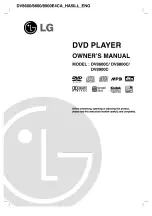
12
TASCAM CD-6010
2 – Names and Functions of Parts
s
PLAY MODE [REPEAT] button
Press this button to cycle through the playback modes
in the following order. (See "Playback modes" on page
23.)
Ordinary
playback
Single
playback
Program
playback
Random
playback
To turn repeat playback ON/OFF, press this button when
in shift mode (when the
SHIFT
indicator is lit) or while
pressing the
SHIFT
button.
During playback or when paused, to turn A-B repeat
mode ON, press and hold this button for at least 1
second when in shift mode (when the
SHIFT
indicator is
lit) or while pressing the
SHIFT
button. (See "A-B repeat
playback" on page 26.)
d
Remote control receiver
This receives signals from the included TASCAM RC-500
wireless remote control. Point the end of the remote
control toward here when using it.
f
ANALOG OUTPUTS (BALANCED) connectors
These are balanced analog outputs for the CD
playback signal. The maximum output level is +24 dBu.
(1: GND, 2: HOT, 3: COLD)
NOTE
The maximum output level of the analog balanced
outputs can be changed internally. Contact our
customer support for details.
g
ANALOG OUTPUTS (UNBALANCED) jacks
These are analog outputs for the CD playback signal.
The maximum output level is +6 dBV.
h
DIGITAL OUTPUTS (COAXIAL) connector
This outputs the CD playback as a S/PDIF or AES/
EBU digital signal. Set the format of the output signal
using the
22 D-OUT
menu item. (See “Digital output
format setting” on page 35.)
NOTE
When playing back MP3 or WAV files, the sampling
•
frequency of this unit’s digital outputs is 44.1 kHz.
When using the pitch control function while playing
•
an audio CD or another disc with MP3 or WAV files, the
digital output is at a fixed sampling frequency of 44.1
kHz.
j
DIGITAL OUTPUTS (XLR) connector
This outputs the CD playback as a S/PDIF or AES/
EBU digital signal. Set the format of the output signal
using the
22 D-OUT
menu item. (See “Digital output
format setting” on page 35.)
k
CONTROL I/O RS-232C connector
This is a D-sub 9-pin RS-232C serial control connector.
Connect an external controller, for example, here. (See
“Using the RS-232C connector” on page 34.)
l
CONTROL I/O PARALLEL connector
This is a D-sub 25-pin parallel control connector. Use
this to connect an external controller, for example. (See
"Relay playback" on page 31, “Fader start and stop” on
page 34 and “Using the parallel connector” on page
35.)
;
AC IN connector
Connect the included power cord here.
Rear panel













































